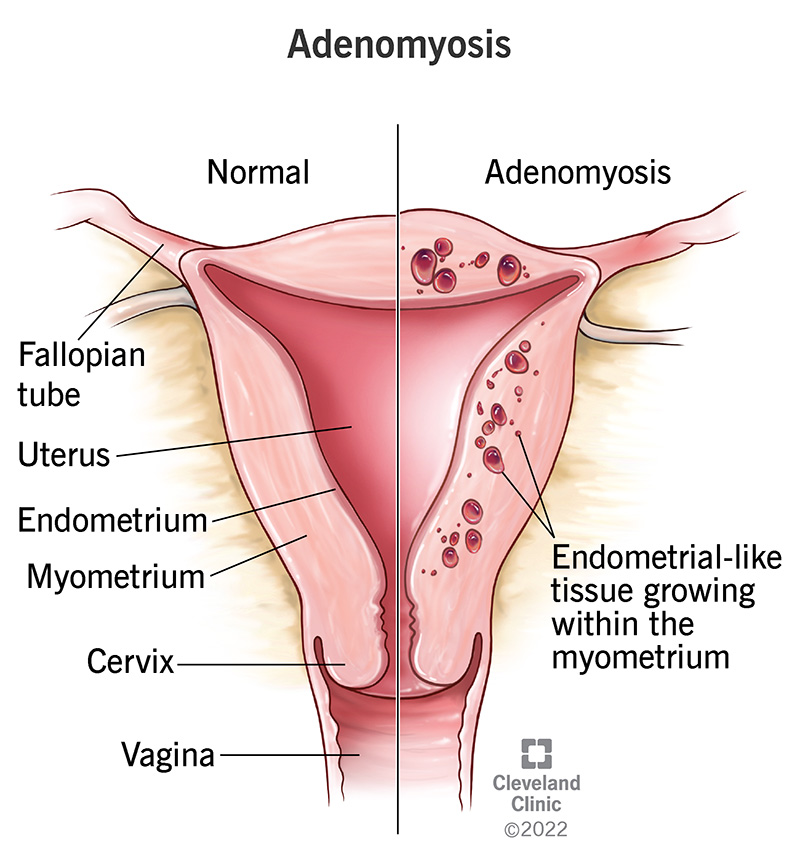Adenomyosis occurs when tissue from the lining of your uterus grows into your uterine wall. It can cause your uterus to double or triple in size. Symptoms include heavy periods, cramping and painful sex. It’s typically treated with medication or surgery.
Advertisement
Cleveland Clinic is a non-profit academic medical center. Advertising on our site helps support our mission. We do not endorse non-Cleveland Clinic products or services. Policy

Adenomyosis (pronounced “add-en-o-my-OH-sis”) is when tissue similar to the lining of your uterus (endometrium) starts to grow into the muscle wall of your uterus (myometrium). It causes your uterus to thicken and enlarge — sometimes, up to double or triple its usual size. Adenomyosis can cause painful periods, heavy or prolonged menstrual bleeding with clotting and abdominal/pelvic pain.
Advertisement
Cleveland Clinic is a non-profit academic medical center. Advertising on our site helps support our mission. We do not endorse non-Cleveland Clinic products or services. Policy
Many women aren’t aware they have adenomyosis because it doesn’t always cause symptoms. The exact prevalence of adenomyosis is unknown. However, researchers know it’s more common in people who:
Approximately 2% to 5% of adolescents with severely painful cycles have adenomyosis.
About 1 in 3 people with adenomyosis don’t have signs or symptoms. Some people experience:
Researchers don’t know why some people develop adenomyosis or what causes it. However, some research suggests hormones, genetics, inflammation or trauma may contribute to adenomyosis.
Adenomyosis most commonly occurs in women who:
However, providers are diagnosing adenomyosis more frequently in people in their 30s who have abnormal vaginal bleeding or painful periods.
Advertisement
The symptoms of adenomyosis tend to get worse over time. Heavy menstrual bleeding from adenomyosis increases your risk of anemia. Anemia occurs when your body doesn’t have enough iron-rich red blood cells. Anemia may cause you to feel fatigued or cold.
No. Adenomyosis itself doesn’t cause cancer or lead to cancer.
Healthcare providers often suspect adenomyosis based on your symptoms and one or more of these tests:
Your provider may rule out more serious conditions with a biopsy. During a biopsy, your provider collects tissue and tests it for signs of more serious diseases.
Because the hormone estrogen promotes endometrial tissue growth, adenomyosis symptoms often go away after menopause. In the meantime, these treatments can ease pain, and help with heavy bleeding and other symptoms:
Left untreated, adenomyosis can lead to infertility or miscarriage. This is because the embryo can’t implant into your uterine lining. Other problems may include chronic pelvic and abdominal pain.
Many people who experience life-disrupting symptoms from adenomyosis find relief through treatment. After menopause, symptoms should go away. But you may still have an enlarged uterus.
Adenomyosis tends to affect women who have had at least one child. However, the condition may make it difficult to conceive for the first time or to have another child. Once you’re pregnant, there’s an increased risk of:
Advertisement
As the cause of adenomyosis isn’t well understood, healthcare providers don’t know of anything you can do to prevent it.
You should call your healthcare provider if you experience:
If you have adenomyosis, you may want to ask your healthcare provider:
Adenomyosis and endometriosis are disorders that involve endometrial-like tissue. Both conditions can be painful. Adenomyosis is more likely to cause heavy menstrual bleeding. The difference between these conditions is where the tissue grows.
Adenomyosis doesn’t usually cause any serious complications. It can lead to difficulty conceiving or miscarriage. The symptoms it causes can disrupt your daily life. Don’t be afraid to talk to your healthcare provider about ways you can feel better.
Advertisement
There aren’t any life-threatening dangers of adenomyosis. It can cause heavy bleeding, prolonged menstrual bleeding and pelvic pain.
You may not know you have adenomyosis. The condition doesn’t always cause symptoms. When symptoms occur, such as heavy periods, cramping or painful intercourse, they can disrupt your life. Talk to your healthcare provider about ways to ease symptoms. Certain medications can help. If you don’t plan to have children, a hysterectomy to remove your uterus can cure the condition. Symptoms tend to go away after menopause.
Advertisement
If you have adenomyosis, it can get in the way of your plans. Cleveland Clinic’s experts work with you to craft a treatment plan that fits your life.

Last reviewed on 01/30/2023.
Learn more about the Health Library and our editorial process.